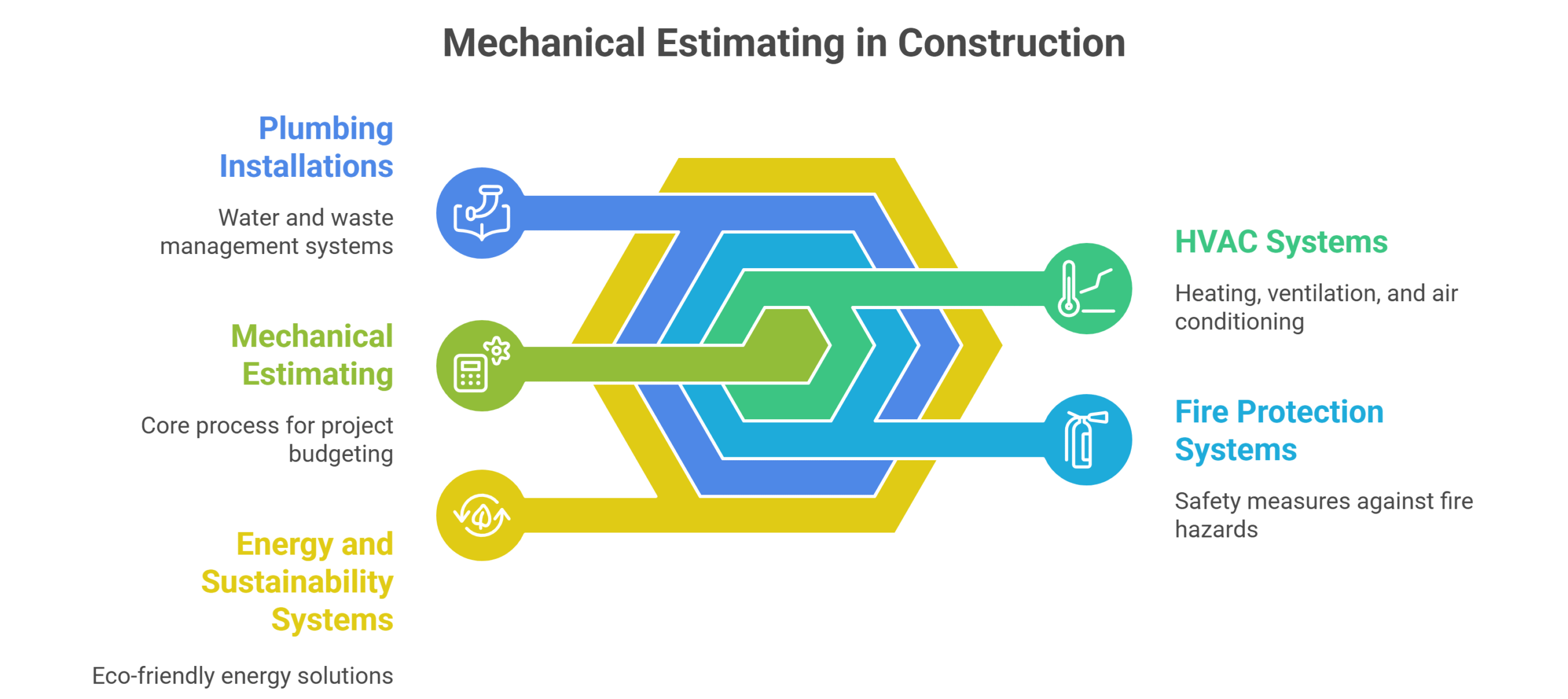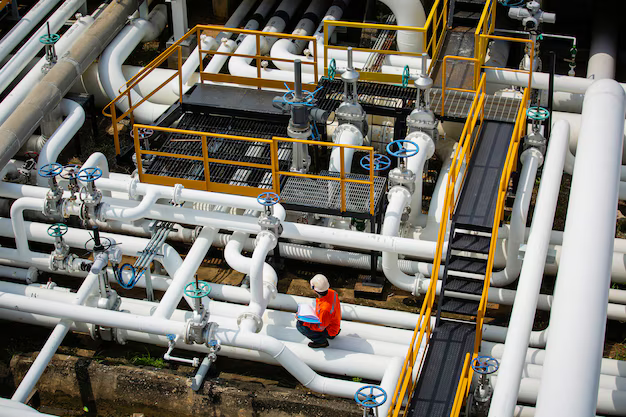Mechanical estimating is the process of predicting the costs involved in mechanical work, including HVAC systems, plumbing, and electrical installations. Key factors affecting cost estimation include project size, material quality, and labour rates. According to industry reports, HVAC estimating accounts for approximately 30% of total construction costs in commercial projects.
Where Mechanical Estimating Is Essential in Construction Projects?
Public infrastructure like hospitals and private ventures such as industrial warehouses demand spot-on mechanical estimating to align budgets with complex service needs. Over 90% of Australian construction firms depend on detailed take-offs for seamless MEP integration during early planning stages, avoiding costly surprises later on.

Mechanical estimating underpins broader construction trade estimating by fostering collaboration among teams. Coordinating with electrical and structural experts early cuts rework by up to 28%, as per recent industry studies. For instance, integrating joinery estimating ensures smooth service routing without clashing with cabinetry installations, enhancing site productivity.
HVAC, Fire Protection, and Plumbing Installations
Estimators dive into quantifying duct lengths, sprinkler networks, and pipe configurations to gauge equipment demands and setup expenses accurately. Key entities include thermal performance for energy efficiency, hydraulic systems for fluid flow, and service routing to minimise disruptions. HVAC alone often accounts for about 30% of mechanical packages in commercial setups.
Industrial Plants, Hospitals, and Commercial Buildings
High-stakes settings like factories and medical centres require mechanical estimating that prioritises precision in ventilation, gas delivery, and piping to uphold safety standards. This approach not only ensures regulatory compliance but also predicts maintenance needs, reducing downtime in environments where reliability is non-negotiable.
Energy and Sustainability Systems in Modern Designs
Today’s estimators incorporate features like heat recovery units and eco-friendly chillers into budgets, balancing upfront costs with long-term savings. Terms such as energy modelling, emission reduction, and life-cycle cost estimation guide decisions, especially as renewable-focused tenders in Australian projects surged significantly since 2022 amid green policy shifts.
Core Elements Mechanical Estimators Evaluate Before Tendering
Before submitting bids, mechanical estimators scrutinise blueprints, schematics, and coordination plans to tally precise component volumes. This step locks in reliable budgets and weaves in practical insights from subs and engineers, setting the stage for smooth project execution without inflated contingencies.
- Ductwork, piping, and insulation quantities
- Equipment capacities and installation requirements
- Site service routes and access constraints
- Local code requirements and fire safety provisions
Pre-bid assessments refine rates against regional benchmarks and supplier stocks, aligning timelines across trades to prevent overlaps. Industry surveys show these reviews boost mechanical estimating accuracy by over 15%, minimising variances that could erode margins in competitive Australian markets.
Ductwork, Piping, and Equipment Specifications
Analysing materials like steel ducts or copper pipes alongside pressure tolerances helps confirm system viability and cost feasibility. Fabrication expenses can fluctuate 10-15% across states due to transport and labour differences, influencing procurement choices and phased installations for optimal efficiency.
Site Conditions and Service Coordination with Other Trades
Thorough site checks and layout verifications curb conflicts with elements like electrical conduits or structural beams. Entities such as clash detection via software, access pathways for maintenance, and BIM coordination streamline workflows, tying into comprehensive construction trade estimating for cohesive project delivery.
Key Factors Affecting Mechanical Estimating Accuracy
Accuracy in mechanical estimating hinges on managing material price volatility, labour cost fluctuations, system complexity, and compliance with Australian codes like the NCC. Recent data shows construction labour costs increased by 3.5% over the past year, per Altus Group, while material inputs rose 0.9% in the June quarter, demanding vigilant adjustments to avoid overruns.Australian construction price outlook – Q2 2025
Material Pricing and Regional Labour Costs
Volatility in supplies and wages poses major risks to precise forecasts in mechanical estimating. Australian indices report a 3.5% rise in construction labour costs over the past year, with entities like the Rawlinsons index tracking supply chain shifts that demand vigilant adjustments.
System Complexity and Installation Timeframes
Sophisticated setups, from variable refrigerant flow units to chilled loops, extend labour hours and oversight needs, skewing projections if overlooked. Underestimating these can inflate total costs, underscoring why seasoned estimators factor in real-world sequencing to maintain contractual viability.
Australian Compliance Codes and Performance Standards
Aligning plans with the NCC, AS1668 for ventilation, and AS1851 for maintenance ensures safety and unlocks certifications. This not only bolsters warranty claims but also integrates performance benchmarks into mechanical estimating, fostering trust in sustainable installations nationwide.
- NCC mechanical compliance sections
- Fire & smoke control standards (AS1668)
- Maintenance performance verification (AS1851)
Estimating Methods Used Across Mechanical Trades
Mechanical estimating employs manual sheets for basic breakdowns or digital models for advanced quantification, blending traditional drawing reviews with automated cost databases. This evolution supports HVAC estimating by providing scalable tools tailored to project scopes.
| Estimating Method | Description | Accuracy Range |
|---|---|---|
| Manual Take-Off Sheets | Traditional drawing-based quantification | ±15% |
| BIM-Integrated Workflow | 3D model with real-time data link | ±5% |
| Hybrid Cost Approach | Combines digital tools with human verification | ±8% |
Traditional Take-Off Sheets vs BIM-Integrated Workflows
Manual extraction from plans contrasts with model-driven approaches that offer version control and auto-detections for clashes. Entities like 3D coordination, data-driven quantification, and cloud collaboration cut time losses, making BIM ideal for intricate HVAC estimating in multi-trade environments.
Cost Breakdown Structures for HVAC and Fire Systems
Segmenting expenses by packages such as ducts, sprinklers, and valves facilitates tight budget oversight using Rawlinsons benchmarks. This transparency in mechanical estimating improves cash flow forecasts and client updates, exemplified in a Melbourne hospital retrofit where detailed CBS prevented overruns.
Leading Software and Digital Tools for Mechanical Estimating
Estimators harness platforms like CostX for dynamic take-offs and Cubit for modular breakdowns, automating quantities while syncing with live supplier data to refine bids swiftly. These tools elevate HVAC estimating by embedding real-time pricing and compliance checks.
- CostX for live take-offs
- Cubit for modular estimating
- Buildsoft for HVAC systems
- Cordell for supplier integration
Digital adoption in Australian construction jumped 20% from 2023 to 2024 per Deloitte, signalling a broader embrace of tech for sharper, more collaborative mechanical estimating practices.
Accurate Mechanical Estimating Builds Long-Term Project Value
Solid mechanical estimating aligns projects with performance benchmarks, regulatory demands, and fiscal targets, curbing overruns while bolstering bid strength. In Australia’s dynamic sector, it cultivates client confidence and underpins profitable, eco-conscious deliveries that stand the test of time.


